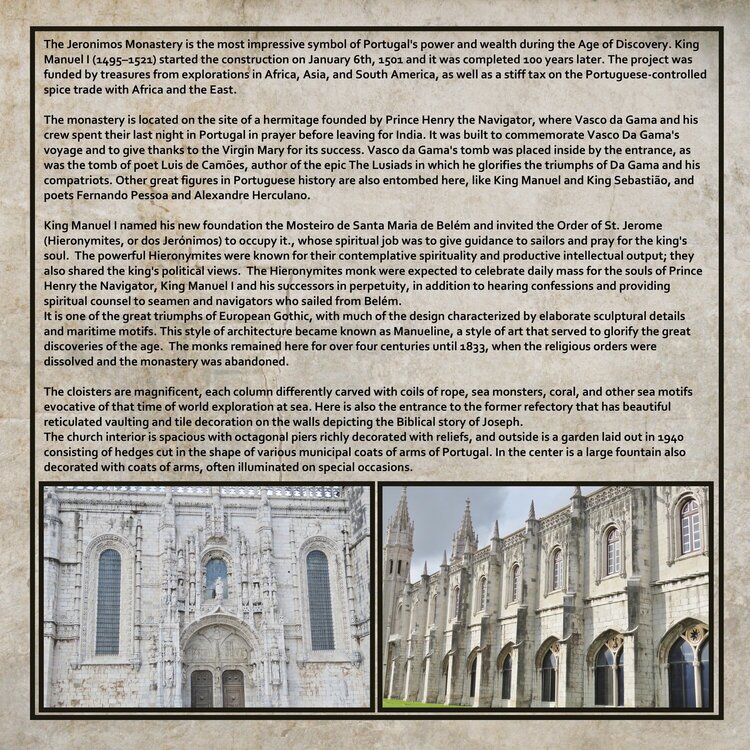

 Give a Cheer
Give a Cheer
I didn't like the wording on the page - too many sentences went on and on and on...
This is the newly edited jounaling - if you see errors here, let me know. The journaling on the left has been changed to this.
The Jeronimos Monastery is the most impressive symbol of Portugal's power and wealth during the Age of Discovery. King Manuel I (1495–1521) started the construction on January 6th, 1501 and it was completed 100 years later. The project was funded by treasures from explorations in Africa, Asia, and South America, as well as a stiff tax on the Portuguese-controlled spice trade with Africa and the East.
The monastery is located on the site of a hermitage founded by Prince Henry the Navigator, where Vasco da Gama and his crew spent their last night in Portugal in prayer before leaving for India. It was built to commemorate Vasco Da Gama's voyage and to give thanks to the Virgin Mary for its success. Vasco da Gama's tomb was placed inside by the entrance, as was the tomb of poet Luis de Camões, author of the epic, The Lusiads, in which he glorifies the triumphs of Da Gama and his compatriots. Other great figures in Portuguese history are also entombed here, like King Manuel and King Sebastião, and poets Fernando Pessoa and Alexandre Herculano.
King Manuel I named his new foundation the Mosteiro de Santa Maria de Belém and invited the Order of St. Jerome (Hieronymites) to occupy it. Their spiritual job was to give guidance to sailors and pray for the king's soul. The powerful Hieronymites were known for their contemplative spirituality and productive intellectual output; they also shared the king's political views. The Hieronymite monks were expected to celebrate daily mass for the souls of Prince Henry the Navigator, King Manuel I and his successors in perpetuity, in addition to hearing confessions and providing spiritual counsel to seamen and navigators who sailed from Belém.
The monks remained here for over four centuries until 1833, when the religious orders were dissolved and the monastery was abandoned.
The cloisters are magnificent, each column differently carved with coils of rope, sea monsters, coral, and other sea motifs evocative of that time of world exploration at sea. Here is also the entrance to the former refectory that has beautiful reticulated vaulting and tile decoration on the walls depicting the Biblical story of Joseph.
The church interior is spacious with octagonal piers richly decorated with reliefs, and outside is a garden laid out in 1940 consisting of hedges cut in the shape of various municipal coats of arms of Portugal. In the center is a large fountain also decorated with coats of arms, often illuminated on special occasions.
No products have been added to this project.
Thanks for spreading positivity!
October 18, 2017
October 16, 2017
October 12, 2017
October 12, 2017
October 10, 2017
October 10, 2017